GOL Bundle
Can GOL Airlines Soar Again After Bankruptcy?
GOL Linhas Aéreas, a major player in the Brazilian aviation market, is at a critical juncture. Having filed for Chapter 11 bankruptcy in January 2024, the airline's future hinges on its strategic roadmap for recovery and growth. Understanding GOL's GOL SWOT Analysis is crucial for assessing its potential.
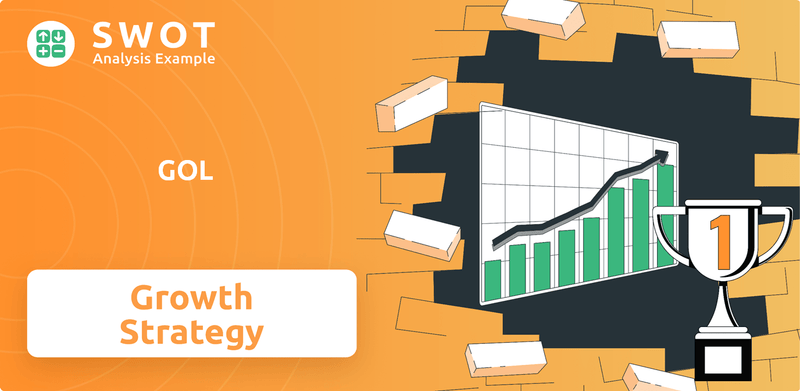
This analysis dives deep into GOL's GOL growth strategy and evaluates its GOL future prospects, considering its GOL company analysis within the dynamic airline industry. We'll explore how GOL, a significant GOL airline in South America, plans to navigate challenges and leverage opportunities, impacting its GOL financial performance and GOL market position. The examination will cover everything from GOL airline expansion plans and strategies to Future financial outlook for GOL company, providing actionable insights for investors and stakeholders.
How Is GOL Expanding Its Reach?
As part of its GOL growth strategy, the airline is actively pursuing several expansion initiatives. These efforts aim to strengthen its market position and diversify revenue streams. The company's focus is on expanding its international network, increasing capacity, and enhancing its operational fleet. This strategic approach is designed to capitalize on emerging opportunities and improve its GOL financial performance.
The airline's expansion plans include both domestic and international routes. This includes new routes for the 2024/2025 high summer season, such as São Paulo/Guarulhos (GRU) to San José (SJO) and Aruba (AUA), and Brasília (BSB) to Cancún (CUN). These moves reflect a proactive strategy to meet growing demand and enhance its service offerings. These initiatives are key to understanding the GOL company analysis and its future trajectory.
The company's commitment to strategic growth is evident in its financial and operational decisions. The airline is also enhancing its operational fleet, aiming to reach 169 jets by 2029, and has added two new Boeing 737 MAX 8 aircraft in Q1 2025, bringing its total to 54 MAX 8 units. These actions are crucial for understanding the GOL future prospects and its ability to adapt to the dynamic airline market.
In Q1 2025, GOL significantly increased its international capacity. The airline increased its international capacity by nearly 50% compared to Q1 2024. Flights to the Caribbean and Central America saw a 200% increase, while flights to South America rose by 24%. This expansion includes new routes and increased frequencies to key destinations.
GOL plans to launch direct flights from São Paulo/Guarulhos to Caracas, Venezuela, starting in August 2025. Exclusive nonstop operations between Belém and Miami are scheduled to begin in June 2025. These new routes are part of the airline's strategy to broaden its international reach and offer more travel options.
Domestically, GOL is focused on disciplined growth, with a 6.3% increase in domestic capacity (Domestic ASK) in Q1 2025. This measured approach allows the company to optimize its operations and maintain profitability. This is one of the strategies to understand Revenue Streams & Business Model of GOL.
The airline is enhancing its operational fleet, aiming to reach 169 jets by 2029. GOL added two new Boeing 737 MAX 8 aircraft in Q1 2025, bringing its total to 54 MAX 8 units. This investment in modern aircraft is designed to improve efficiency and reduce operating costs.
GOL leverages strategic partnerships to expand its network and enhance customer offerings. The codeshare agreement with Azul Linhas Aéreas provides over 2,700 one-stop connection opportunities, expanding domestic networks. The GOLLOG cargo unit is also expanding, with revenue increasing by 17.0% in Q1 2025 and transported weight rising by 6.8%.
- Codeshare agreements with American Airlines and Air France-KLM.
- GOLLOG incorporated its seventh freighter aircraft in 2024.
- GOLLOG operates 58 cargo terminals and 60 stores, covering over 4,000 cities in Brazil.
- GOLLOG's expansion reflects the airline's diversification efforts.
GOL SWOT Analysis
- Complete SWOT Breakdown
- Fully Customizable
- Editable in Excel & Word
- Professional Formatting
- Investor-Ready Format
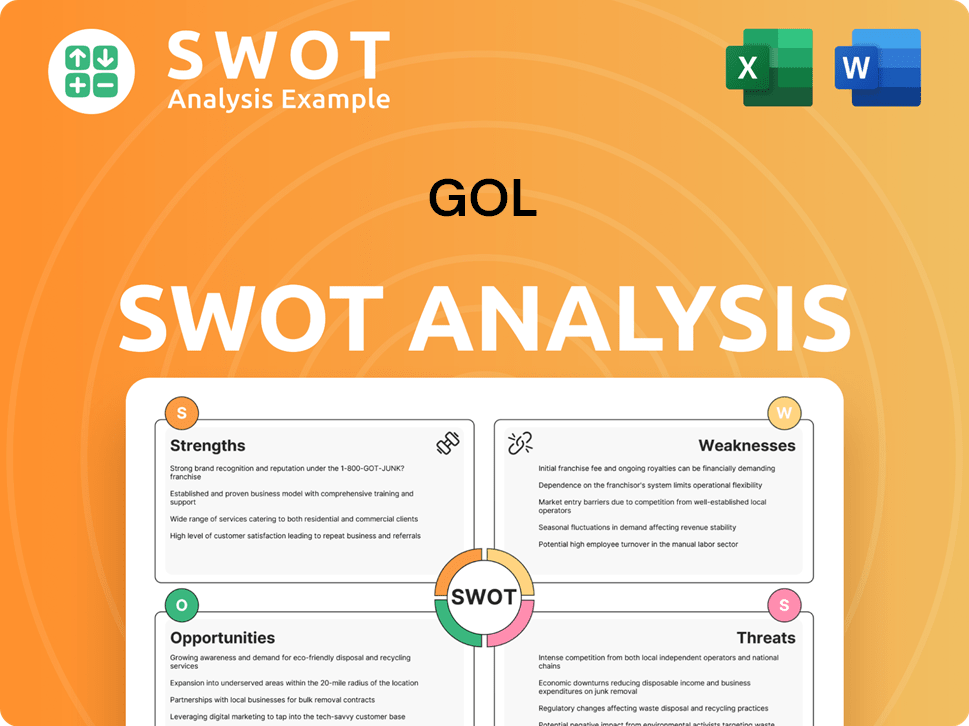
How Does GOL Invest in Innovation?
The innovation and technology strategy of the GOL airline is central to its GOL growth strategy. This approach focuses on digital transformation and enhancing the customer experience to boost its GOL financial performance. The airline's strategic partnerships and investments in new technologies demonstrate its commitment to long-term sustainability and competitiveness in the dynamic airline market.
This strategy includes the adoption of advanced technologies to improve operational efficiency and customer service. Through these initiatives, GOL aims to strengthen its GOL market position and achieve its long-term financial goals. The airline's focus on innovation is a key factor in its adaptation to the changing airline market and its ability to respond to industry challenges.
GOL's commitment to technological advancements is evident in its continued partnership with Sabre, a leading global travel technology company. This collaboration is a cornerstone of GOL's digital transformation efforts, aimed at improving its retailing capabilities and personalizing the customer journey.
In February 2025, GOL extended its collaboration with Sabre, continuing to use Sabre's Passenger Service System (PSS) and Global Distribution System (GDS). This partnership is crucial for GOL's operations and its ability to offer a seamless travel experience.
GOL is implementing SabreMosaic solutions, including Ancillary IQ™ and Dynamic Availability. Ancillary IQ™ uses AI to personalize ancillary offers, while Dynamic Availability optimizes pricing in real-time based on market demand.
GOL is also implementing Sabre's Self-Service Reaccommodation solution. This provides travelers with mobile rebooking options, enhancing satisfaction and streamlining operations. These solutions are designed to improve retailing capabilities and personalize the customer journey.
GOL continues to modernize its fleet with the addition of fuel-efficient Boeing 737 MAX aircraft. In Q1 2025, GOL added two new Boeing 737 MAX 8 aircraft, bringing its total to 54 units. These aircraft are expected to offer 15-20% better fuel efficiency.
GOL's focus on operational excellence is demonstrated by its on-time performance (OTP). In Q1 2025, OTP reached 89.4%, a 6.5 percentage point increase compared to Q1 2024. GOL was also recognized as the most punctual airline in Latin America in January 2025.
These technological integrations are expected to drive higher-quality revenue and strengthen long-term financial sustainability. By improving retailing capabilities and personalizing the customer journey, GOL aims to enhance its overall financial performance and secure its position in the market.
GOL's strategic investments in technology and fleet modernization are designed to enhance its operational efficiency and improve customer satisfaction. These initiatives are key components of its long-term strategy, contributing to its GOL future prospects and its ability to compete effectively in the airline industry. For more insights into the airline's ownership and financial structure, you can read about Owners & Shareholders of GOL.
GOL's innovation and technology strategy includes several key initiatives aimed at improving its operational efficiency, customer experience, and financial performance. These efforts are crucial for adapting to the changing airline market and achieving long-term sustainability.
- Partnership with Sabre: Continued use of PSS and GDS, with the implementation of SabreMosaic solutions like Ancillary IQ™ and Dynamic Availability.
- Ancillary IQ™: Utilizes AI and real-time data to personalize and optimize ancillary offers.
- Dynamic Availability: Optimizes pricing in real-time based on market demand.
- Self-Service Reaccommodation: Provides mobile rebooking options for travelers.
- Fleet Modernization: Adding Boeing 737 MAX aircraft for improved fuel efficiency.
- On-Time Performance: Reached 89.4% in Q1 2025, making it the most punctual airline in Brazil.
GOL PESTLE Analysis
- Covers All 6 PESTLE Categories
- No Research Needed – Save Hours of Work
- Built by Experts, Trusted by Consultants
- Instant Download, Ready to Use
- 100% Editable, Fully Customizable
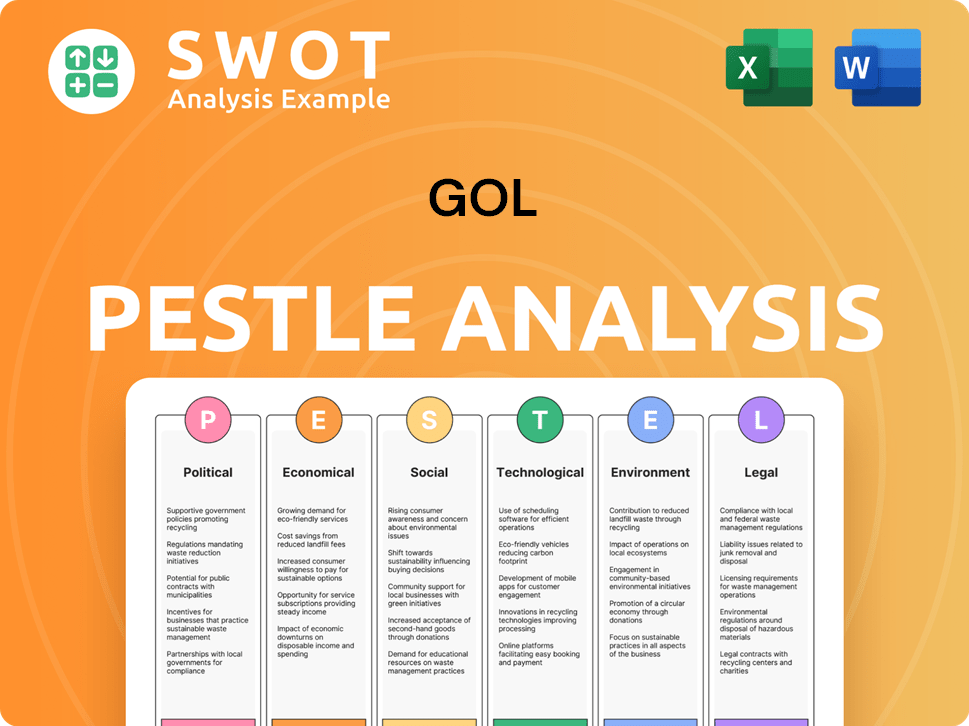
What Is GOL’s Growth Forecast?
GOL Linhas Aéreas, or GOL, is currently undergoing financial restructuring, having filed for Chapter 11 bankruptcy in January 2024. The company aims to emerge from this process by June 2025. This restructuring is a critical step in reshaping the GOL airline's financial health and setting the stage for future growth.
In the first quarter of 2025, GOL demonstrated resilience with a 19.4% year-over-year increase in total net revenue, reaching R$5.62 billion (approximately $986 million). This growth was primarily driven by a significant surge in passenger transport income. However, the company also faced increased costs due to a weaker Brazilian real, higher fuel prices, and increased airport fees, impacting its profitability.
As of April 2025, GOL reported a net revenue of R$1.696 billion (around USD 323 million) and a net loss of R$440 million (roughly USD 83.8 million). The company's total cash position stood at R$2.034 billion (USD 387.4 million), with a net debt of R$30.945 billion (USD 5.89 billion).
In Q1 2025, GOL's total net revenue reached R$5.62 billion ($986 million). Passenger transport income contributed R$4.5 billion ($789 million), a significant driver of revenue growth. The Smiles loyalty program generated R$1.4 billion ($246 million).
Despite revenue growth, GOL's profit dropped by 63.7% to R$1.37 billion ($240 million) in Q1 2025. Costs increased by 24.9% to R$4.77 billion ($837 million). These increased costs were influenced by the weaker Brazilian real, higher aviation fuel prices, and increased airport fees.
GOL secured $1.9 billion in exit financing to support its restructuring and growth. This included a $330 million equity raise and $1.54 billion in new 5-year exit debt financing. The company expects to emerge with approximately $900 million in liquidity.
GOL's five-year plan projects a return to pre-pandemic domestic capacity levels by 2026. The airline aims to expand its fleet to 167 aircraft by 2029. The plan also anticipates an EBITDA margin increase from 23% in 2024 to 34% by the end of the decade.
GOL's financial strategy includes specific targets for debt reduction and margin improvement. The company aims to significantly reduce its leverage and strengthen its financial position as it emerges from restructuring.
- Net Leverage at exit: 5.4x
- Projected net leverage by year-end 2027: 2.9x
- Projected net leverage by year-end 2029: 1.9x
- EBITDA margin target by the end of the decade: 34%
GOL Business Model Canvas
- Complete 9-Block Business Model Canvas
- Effortlessly Communicate Your Business Strategy
- Investor-Ready BMC Format
- 100% Editable and Customizable
- Clear and Structured Layout
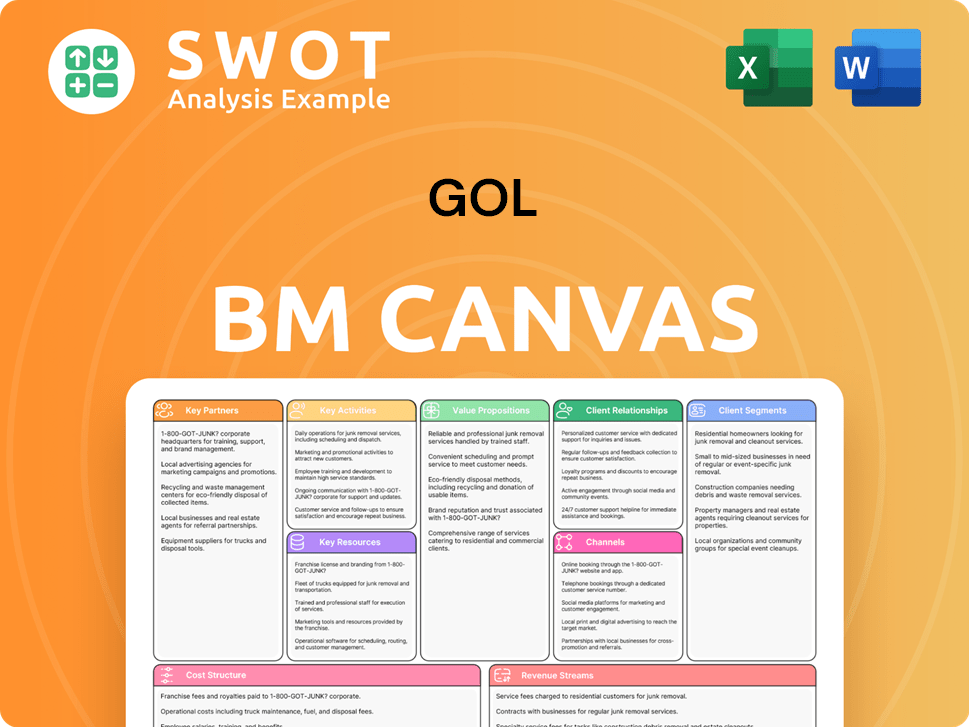
What Risks Could Slow GOL’s Growth?
The GOL airline faces several significant risks and obstacles in its growth strategy. These challenges stem from financial burdens, operational hurdles, and intense market competition. Successfully navigating these issues is crucial for realizing GOL's future prospects and ensuring long-term viability.
A key concern is GOL's substantial debt and its ongoing Chapter 11 bankruptcy proceedings, which commenced in January 2024. This financial strain is compounded by external factors such as a weaker Brazilian real and rising operational costs, which include more expensive aviation fuel and higher airport fees. These factors collectively impact GOL's financial performance and its ability to invest in expansion.
Operational challenges, particularly aircraft delivery delays, also pose a threat to GOL's growth strategy. Delays in receiving new aircraft from Boeing limit the airline's ability to expand its fleet and maintain operational capacity, potentially affecting revenue generation. The competitive landscape further complicates matters, with strong competition from other major Brazilian airlines and potential merger activities.
GOL's high debt, with a net debt of R$31.1 billion ($5.46 billion) in Q1 2025, is a major obstacle. The company's leverage ratio increased from 4.2 to 5.8 times. The Chapter 11 bankruptcy proceedings, although expected to conclude by June 2025, still present significant financial and operational challenges.
Delays in aircraft deliveries from Boeing hinder GOL's fleet expansion plans. Despite receiving two new Boeing 737 MAX 8 aircraft in Q1 2025, persistent delays affect the airline's capacity. Uncertainty surrounding the delivery of 12 Boeing 737 MAX 10s between 2027 and 2030 adds to the operational risks.
GOL faces intense competition from other major Brazilian airlines like LATAM Brasil and Azul. The competitive environment is further intensified by potential merger speculation. The Brazilian airline industry also deals with significant annual costs due to litigation, which could impact GOL's financial stability.
A weaker Brazilian real, coupled with higher aviation fuel costs and airport fees, has increased GOL's operational expenses. Costs rose by 24.9% in Q1 2025, putting additional pressure on profitability. These economic factors significantly influence GOL's financial performance and its ability to compete effectively.
The Brazilian airline industry faces an annual cost of $200 million due to litigation. This high cost impacts GOL's financial stability and reduces available resources for growth initiatives. Managing and mitigating litigation risks is crucial for GOL's long-term financial health and market position.
GOL's costs increased by 24.9% in Q1 2025 due to higher fuel prices, airport fees, and the weaker Brazilian real. These cost increases squeeze profit margins and make it more challenging for GOL to compete effectively. Addressing these rising costs is vital for GOL's financial performance.
To address these risks, GOL has implemented a profit improvement program aimed at achieving $181 million in annual savings. The company has also secured financial support, including $1 billion in debtor-in-possession (DIP) financing. Furthermore, GOL is negotiating concession packages totaling $1.1 billion from lessors and has reached agreements to defer leases and other obligations.
GOL has secured significant financial support to manage its challenges. This includes $1 billion in debtor-in-possession (DIP) financing and concession packages worth $1.1 billion from lessors. These measures are designed to reduce annual costs and improve liquidity, providing a financial cushion during the restructuring period.
GOL Porter's Five Forces Analysis
- Covers All 5 Competitive Forces in Detail
- Structured for Consultants, Students, and Founders
- 100% Editable in Microsoft Word & Excel
- Instant Digital Download – Use Immediately
- Compatible with Mac & PC – Fully Unlocked
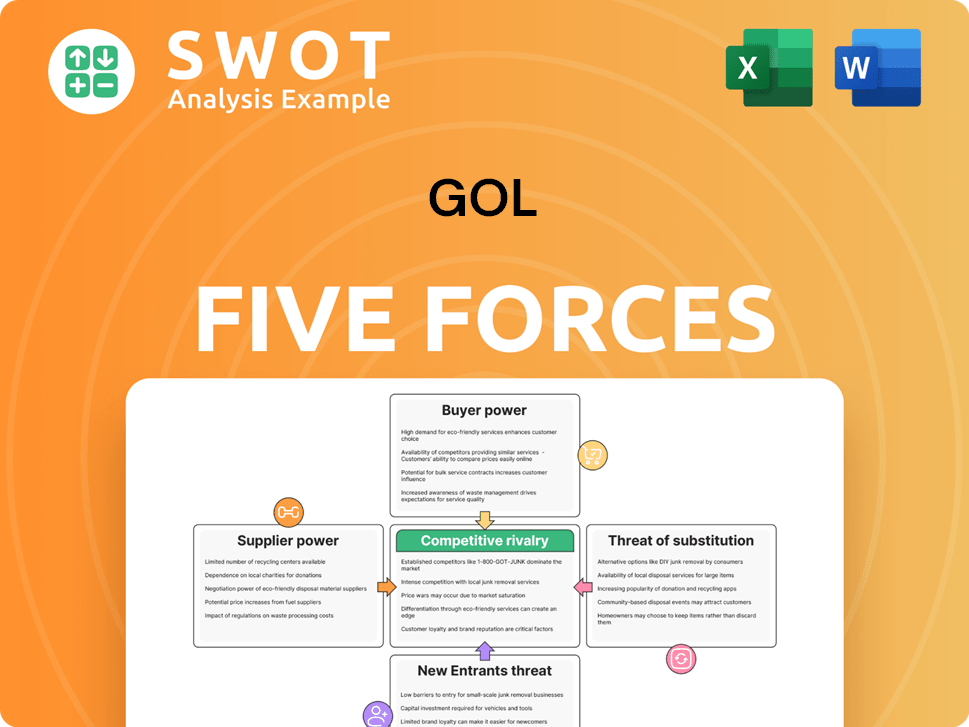
Related Blogs
Disclaimer
All information, articles, and product details provided on this website are for general informational and educational purposes only. We do not claim any ownership over, nor do we intend to infringe upon, any trademarks, copyrights, logos, brand names, or other intellectual property mentioned or depicted on this site. Such intellectual property remains the property of its respective owners, and any references here are made solely for identification or informational purposes, without implying any affiliation, endorsement, or partnership.
We make no representations or warranties, express or implied, regarding the accuracy, completeness, or suitability of any content or products presented. Nothing on this website should be construed as legal, tax, investment, financial, medical, or other professional advice. In addition, no part of this site—including articles or product references—constitutes a solicitation, recommendation, endorsement, advertisement, or offer to buy or sell any securities, franchises, or other financial instruments, particularly in jurisdictions where such activity would be unlawful.
All content is of a general nature and may not address the specific circumstances of any individual or entity. It is not a substitute for professional advice or services. Any actions you take based on the information provided here are strictly at your own risk. You accept full responsibility for any decisions or outcomes arising from your use of this website and agree to release us from any liability in connection with your use of, or reliance upon, the content or products found herein.